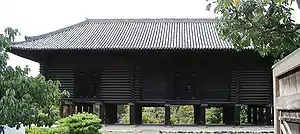Kanshō
Kanshō (寛正) was a Japanese era name (年号,, nengō,, lit. "year name") after Chōroku and before Bunshō. This period spanned from December 1460 through February 1466.[1] The reigning emperors were Go-Hanazono-tennō (後花園天皇) and Go-Tsuchimikado-tennō (後土御門天皇).[2]
| History of Japan |
|---|
 |
Change of era
- 1460 Kanshō gannen (寛正元年): The era name was changed to mark an event or a number of events. The old era ended and a new one commenced in Chōroku 4.
Events of the Kanshō era
- 1460 (Kanshō 1, 9th month): Wakae Castle in Kawachi Province was destroyed when Hatakeyama Yoshinari (畠山 義就, 1437-21 January 1491) was forced out of it.[3]
- 1461 (Kanshō 2): Kanshō famine was ceased.
- August 21, 1464 (Kanshō 5, 19th day of the 7th month): Go-Hanazono resigned his throne in favor of his son, who would be known as Emperor Go-Tsuchimikado.[4]
Notes
- Nussbaum, Louis-Frédéric. (2005). "Kanshō" in Japan encyclopedia, p. 478; n.b., Louis-Frédéric is pseudonym of Louis-Frédéric Nussbaum, see Deutsche Nationalbibliothek Authority File Archived 2012-05-24 at Archive.today.
- Titsingh, Isaac. (1834). Annales des empereurs du japon, pp. 331-351.
- Titsingh, p. 350; Ramirez-Christensen, Experanza U. (1994). Heart's flower: the life and poetry of Shinkei, p. 28.
- Titsingh, p. 351.
References
- Nussbaum, Louis Frédéric and Käthe Roth. (2005). Japan Encyclopedia. Cambridge: Harvard University Press. ISBN 978-0-674-01753-5; OCLC 48943301
- Ponsonby-Fane, Richard Arthur Brabazon. Ponsonby-Fane, Richard. (1956). Kyoto: The Old Capital of Japan, 794-1869. Kyoto: Ponsonby Memorial Society. OCLC 36644
- Titsingh, Isaac. (1834). Nihon Odai Ichiran; ou, Annales des empereurs du Japon. Paris: Royal Asiatic Society, Oriental Translation Fund of Great Britain and Ireland. OCLC 5850691
External links
- National Diet Library, "The Japanese Calendar" -- historical overview plus illustrative images from library's collection
| Preceded by Chōroku |
Era or nengō Kanshō 1460–1466 |
Succeeded by Bunshō |
This article is issued from Wikipedia. The text is licensed under Creative Commons - Attribution - Sharealike. Additional terms may apply for the media files.
